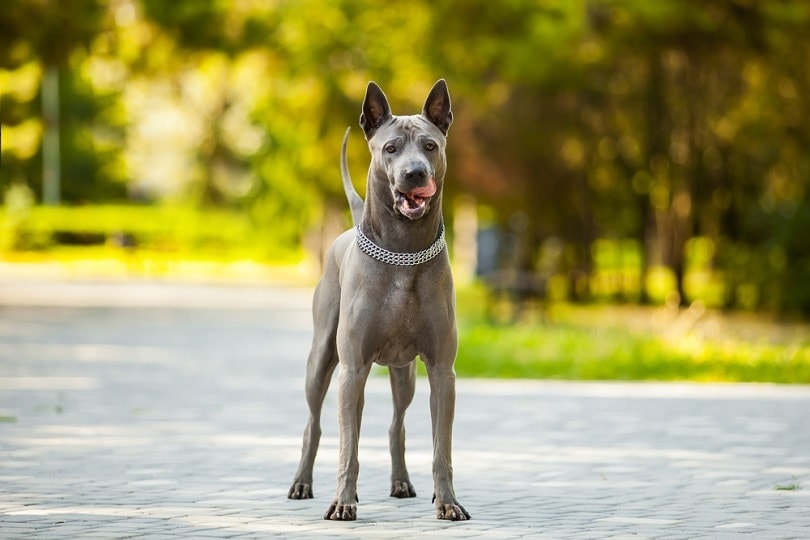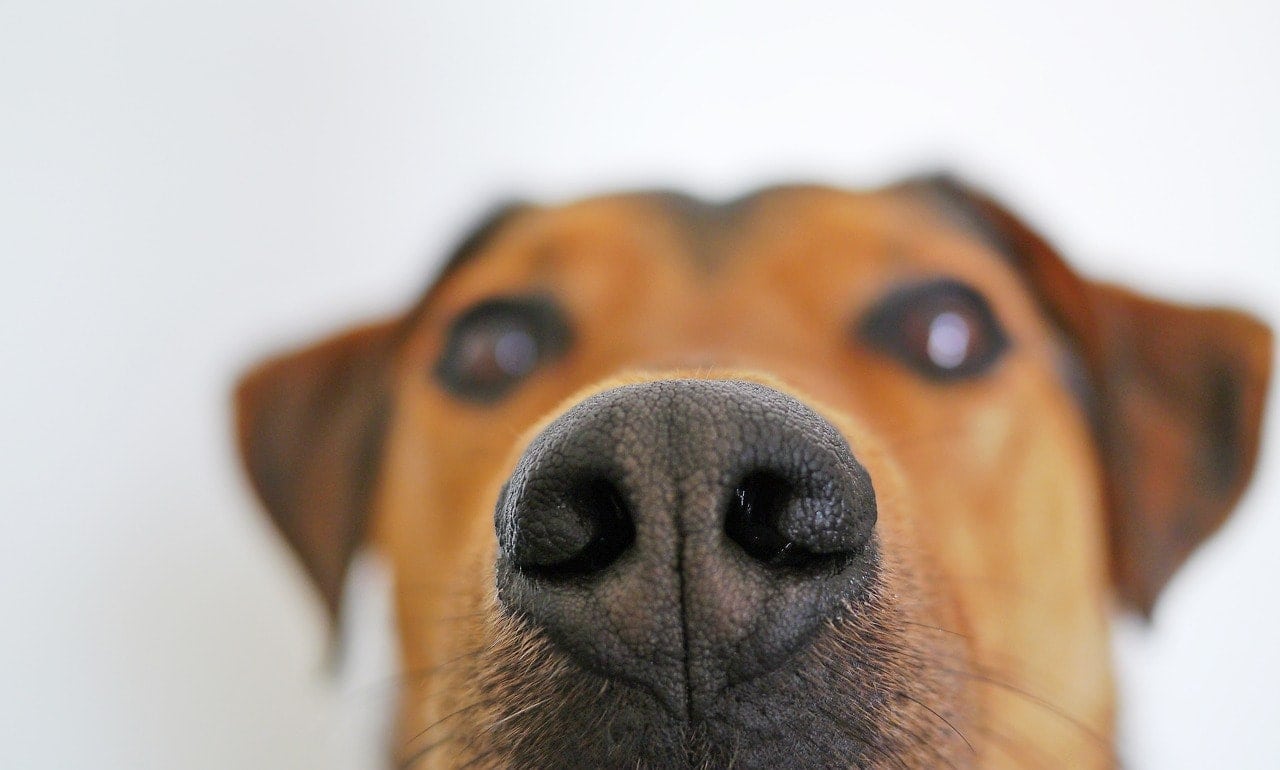DDR German Shepherd: Pictures, Care, Temperament & Traits
Updated on
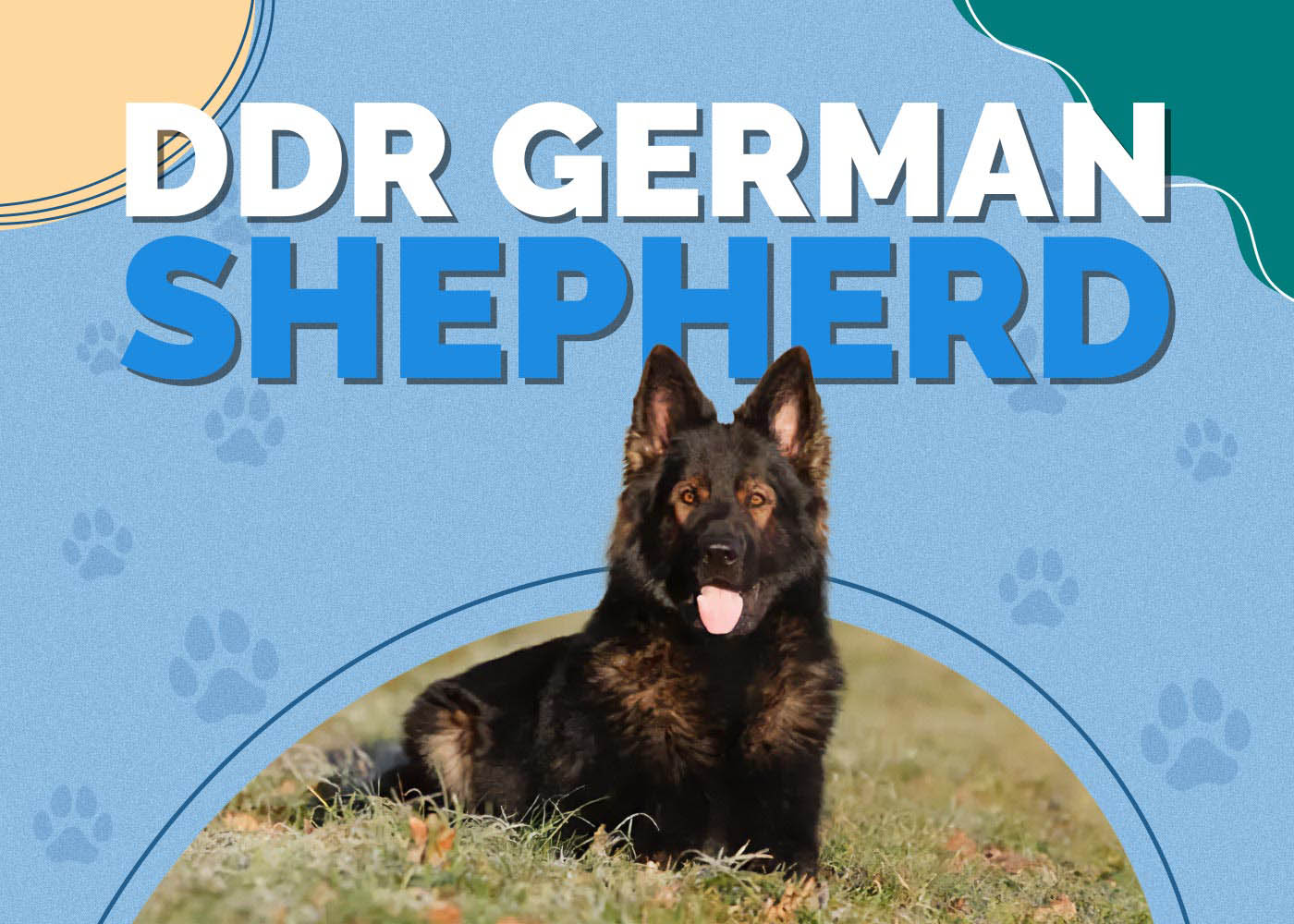
Click to Skip Ahead
Don’t feel bad if you have no idea what a DDR German Shepherd is. This acronym stands for Deutsche Demokratische Republik German Shepherd, which roughly translates to East German Shepherd. As the name suggests, these dogs originated from East Germany during the Cold War era.
They are a bit different than your average German Shepherd as they were selectively bred solely for their protective qualities.
| Height: | 22–26 inches |
| Weight: | 50–95 pounds |
| Lifespan: | 10–13 years |
| Colors: | Black and tan, sable, solid black |
| Suitable for: | Active, experienced dog owners, outdoor enthusiasts, and as working dogs |
| Temperament: | Intelligent, protective, energetic |
Because these dogs were bred primarily for police and military work, they are more robust and heavier than their American companions. They are built mostly for working conditions, so they tend to be more practically bred. That said, they are very versatile dogs. They can make great herding and guarding dogs, though some people also keep them as companions.
It’s important to note that DDR German Shepherds are not a separate breed but a distinct line within the German Shepherd breed. They are fairly different from your average show-line German Shepherd, though.
DDR German Shepherd Breed Characteristics
DDR German Shepherd Puppies
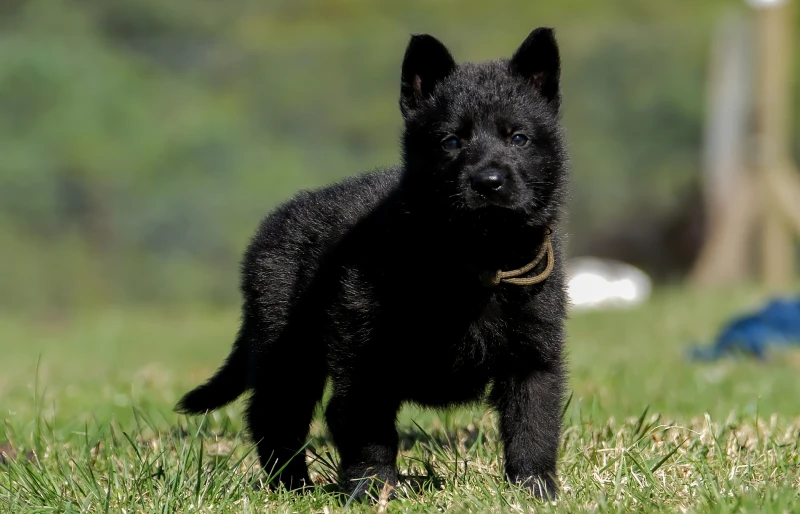
DDR German Shepherd puppies act a lot like any other puppy. They are very active and require regular bouts of exercise to stay strong. They’re also rather intelligent and have a strong work ethic. Right away, they usually take well to training although we still recommend starting them on training very early.
Socialization is vital, as these dogs can be overly protective unless introduced to a wide range of safe things early on. They tend to assume anything they aren’t familiar with as a threat, which means that you need to expand their list of familiar things. Their protective nature begins to show at even a young age, so training and socialization should begin as soon as possible.
Finding a DDR German Shepherd is challenging. However, they are becoming more and more popular as show-line German Shepherds move away from purpose and more towards appearance. Still, you do need to seek out a reputable breeder who specializes in DDR lines. Research and contact this breed to ensure they breed reputable dogs and provide proper health testing for all their dogs.
Be prepared to wait for a puppy, as most of these breeders have a waiting list. We recommend visiting the breeder in person, meeting the parents, and assessing the dog’s living conditions before handing over any deposit. Be cautious of online listings that don’t require a waiting list or application.
Temperament & Intelligence of the DDR German Shepherd 🧠
For the most part, these dogs were bred for their temperament and intelligence. Therefore, they tend to carry many traits that are important for working dogs. They tend to be extremely loyal to their owners and families. Even from an early age, they form strong bonds with their loved ones and caretakers. They have natural protective instincts that make them work great as guard dogs, and they’re very alert to changes in their environment.
Their trainability is one of their standout features. They are extremely eager to please and quick to learn, allowing them to excel at any type of training. They can perform just about any role or activity.
Proper socialization from a young age is essential to ensure they are well-adjusted around other dogs and people. Early exposure to different environments and situations can help prevent excessive shyness or aggression. We highly recommend working with a professional trainer and getting them involved in puppy classes from an early age.
DDR German Shepherds are one of the most intelligent dog breeds, and it shows. They can grasp new commands extremely fast, and nothing beats their work drive. However, these traits do mean they can get bored easily, so you must be ready to constantly challenge their mind.
Are These Dogs Good for Families? 👪
In some cases, these dogs can be good for families. However, they were not bred to be companion dogs, which can make them a bit much for most families. These dogs are extremely active and require regular exercise and mental stimulation. It helps if you already live an active lifestyle and have plenty of time to exercise with your dog. They need as much as 2 hours of exercise a day.
Their intelligence means that they can become bored if they aren’t being challenged. After initial training is done, it can be hard to come up with new things for them to learn.
DDR German Shepherds thrive on human companionship and can suffer from separation anxiety if left alone for long periods. Families should be prepared to spend time with their dogs and not leave them isolated for extended periods. They are a dog breed that requires much more time and commitment than others.
Does This Breed Get Along with Other Pets?
When properly trained and socialized, these dogs will get along with other pets. However, it’s important to introduce them to different animals at an early age to ensure that they see them as friends—not threats.
Because these dogs are so obedient, they can easily be taught to get along with other pets. They’re likely to respond to command even when in the presence of a new animal, which can make them much easier to manage. They may still have a natural prey drive and be inclined to chase small animals, though.
Of course, individual temperament does matter to some extent. Some dogs may have a lower prey drive than others, for instance.
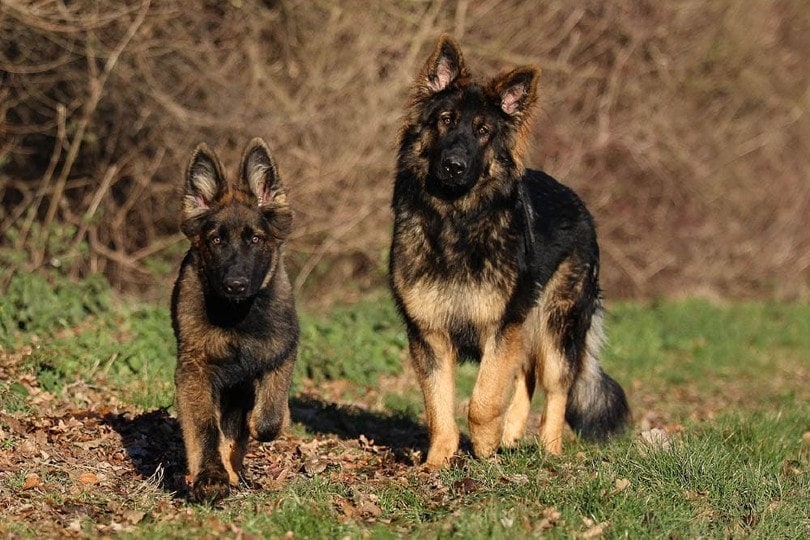
Things to Know When Owning a DDR German Shepherd
Food & Diet Requirements 🦴
For the most part, these dogs don’t require any special dietary needs. A high-quality, commercial diet is the best option for most. Look for a diet that is designed for active dogs, as these canines tend to spend more time moving than others. Many also benefit from a large-breed formula, especially if they are on the bigger side.
That said, you should adjust your dog’s diet to meet their needs. If your dog is gaining too much weight, consider switching to a lower-calorie food. If your dog isn’t gaining proper muscle mass, consider switching to a higher-quality food.
Exercise 🐕
Out of all the dog breeds out there, these canines are some of the most active. You should aim to spend at least 2 hours exercising them every day. Divide this into several sessions of varied exercises. For instance, you could take a brisk walk in the morning, have a fetch session in the afternoon, and then play an active game before bed.
These dogs are very intelligent, and they need a lot of mental exercise, too. You can combine mental and physical exercise by choosing activities that require dogs to do both. Hiking in a new area can fulfill both needs, for instance. Incorporate obedience training into their exercise routine. Teaching commands and practicing them regularly not only helps with their behavior but also provides mental stimulation.
Avoid forcing puppies to exercise, even if they are a bit hyperactive. If your dog puts too much strain on their joints while they’re growing, they can develop hip dysplasia and other chronic conditions.
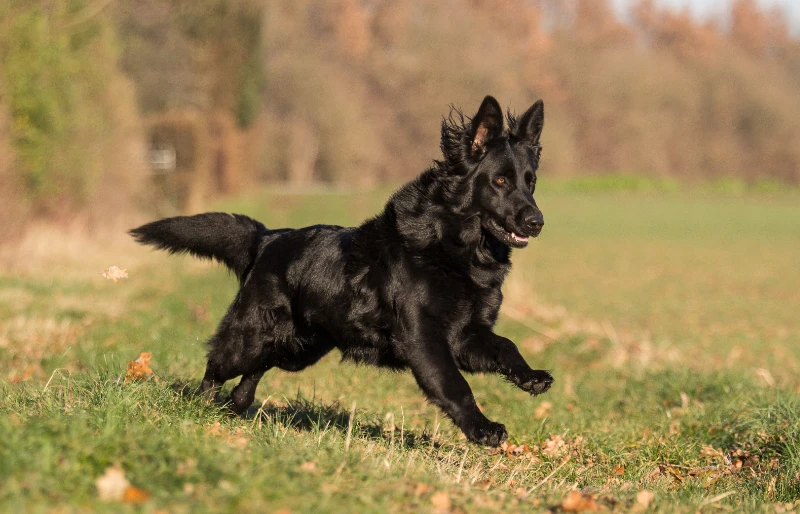
Training 🎾
If you’re getting a DDR German Shepherd, odds are that you want your dog to be well-trained. Training is an essential part of properly caring for these dogs.
Start training as soon as you bring your puppy home. Quality breeders will start training and socialization before the puppies are old enough for their forever homes, and you should continue this routine after you purchase your puppy. Get your dog enrolled in puppy classes, which provide a training schedule and socialization for your pooch. We don’t recommend private classes, as these are more expensive and don’t provide as much socialization. Private training classes are really only best for aggressive dogs or those with very specific behavioral issues.
Use positive reinforcement training and lean on your relationship with your dog. These dogs bond closely with their people and want to please them. Start with basic commands, incorporating them into your routine as you go. For instance, teach your dog to “sit” first. Then, make your canine sit before going outside for a walk or getting fed. By incorporating commands into your routine, you practice them and ensure your dog knows what the commands mean outside of training.
Sometimes, dogs have a hard time “generalizing” commands. In other words, they don’t understand that “sit” means the same thing everywhere—even outside of training sessions. Practice in daily life is the best way to combat this training issue.
Grooming ✂️
Grooming a DDR German Shepherd is pretty straightforward. However, they are heavy shedders, so you should plan on brushing them daily, if not twice a day. Regular brushing helps remove loose fur and keep these dogs clean, as the brush can knock dust and debris out, too.
German Shepherds typically do not require frequent baths. Bathing every few months or when they get visibly dirty is usually sufficient. Use a dog-specific shampoo to avoid drying out their skin. More baths are not better, as they can lead to skin irritation by stripping your dog’s natural oils—only bathe your dog when you really need to.
Of course, you’ll also need to care for your dog’s nails and ears. Trimming their nails will be required on a regular basis, and you can accomplish this at home pretty easily. Their ears often don’t need tons of cleaning, but excessive dirt and debris in their ears can lead to infections.
Health and Conditions ❤️
Because they were bred to work, DDR German Shepherds tend to be very healthy.
Hip dysplasia is the most common condition for these dogs (and other large breeds). This involves the abnormal development of the hip joint, often during puppyhood. Excessive wear occurs, leading to arthritis and lameness at a fairly early age. This condition is partially genetic, but environmental factors (like excessive exercise in puppies) also play a role.
Degenerative myelopathy can also occur and is considered to be mostly genetic. This progressive neurological condition affects the spinal cord and leads to limb weakness (and eventually paralysis). It’s more common in older dogs.
Some German Shepherds may develop EPI, a condition in which the pancreas doesn’t produce enough digestive enzymes. This can lead to malnutrition and weight loss.
- Allergies
- Hip dysplasia
- Degenerative myelopathy
- EPI
- Bloat
- Epilepsy
Male vs. Female
The only significant difference between the males and females of this breed is their size. Males tend to be significantly larger than females. Keep this in mind when selecting between a male or female puppy.
Beyond that, there is no proof that sex significantly impacts temperament or trainability. Many people have theories, but it seems that temperament differences are mostly associated with how the dog is raised.
3 Little-Known Facts About the DDR German Shepherd
1. They were selectively bred for working.
DDR German Shepherds were originally bred in East Germany during the Cold War era. They were solely bred for their exceptionally working ability—not to conform to an appearance standard. Therefore, these dogs tend to be more robust and trainable than your average German Shepherd.
2. DDR German Shepherds have surprisingly strong scenting abilities.
Surprisingly, these dogs have strong scenting abilities, allowing them to perform roles like search and rescue and tracking. They have an acute sense of smell and high intelligence, making them very effective in these roles.
3. They’re very cold-tolerant.
Because of where they were bred, these dogs are very cold-tolerant. They have a thick double coat that protects them from snow and colder weather.
Final Thoughts
DDR German Shepherds differ from American German Shepherds because they were bred solely for practical, working abilities. Therefore, they are extremely trainable and robust, while they vary more in appearance. If you’re looking for a working German Shepherd, choosing this line may be helpful.
That said, they can be a handful for those that aren’t prepared. They require a lot of exercise and socialization to thrive, which can be difficult for more casual dog owners to handle. Therefore, they’re only a good option for very specific dog owners.
Featured Image Credit: Sebastian_Wolf, Shutterstock




